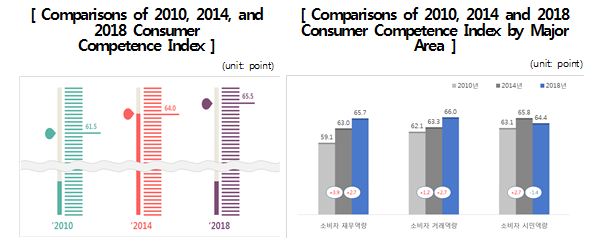KCA News & Media
Press Release
Press Release
| Consumer competence steadily improved, increasing by 1.5 points compared to 2014 | ||||||
|---|---|---|---|---|---|---|
| Date | 2018-12-05 | Hit | 1521 | |||
|
Consumer competence steadily improved, increasing by 1.5 points compared to 2014 - Competencies to understand and utilize consumer information and to assert consumer rights are low, requiring enhancement of consumer education -
The level of consumer competence of individual consumers* in Korea has been steadily improving as a result of various policy efforts. However, it has been found that the levels of competencies to △understand and utilize consumer information and △assert consumer rights are relatively low compared to other capabilities, and there is a significant difference in the level of consumer competence depending on age, income, educational level and consumer education experience.
□ The level of consumer competence steadily increased, reaching 65.5 points, up 1.5 points compared to 2014. The Korea Consumer Agency (KCA, President Hee-sook Lee) conducted a “2018 Consumer Competence Index” survey for the 3rd time subsequent to the 2010 and 2014 surveys in order to comprehensively measure the level of consumer competence of Korean adults. The survey found that the 2018 Consumer Competence Index averaged 65.5 points (out of 100 points), up 1.5 points compared to the second survey conducted in 2014 (61.5 points in 2010 → 64.0 points in 2014 → 65.5 points in 2018).
By major area, consumer financial competence (65.7 points) and consumer transactional competence (66.0 points) are on an upward trend compared to 2014 (each area increased by 2.7 points), whereas consumer citizenship competence fell slightly to 64.4 points from 65.8 points in 2014, indicating the lowest level among the three major areas.
□ Competencies to understand and utilize consumer information and to assert consumer rights are low, requiring enhancement of consumer education. By sub-area, consumer competence evenly increased in all sub-areas compared to 2014, but only △the level of competence to assert consumer rights dropped by 3.3 points. In more detail, for consumer transactional competence, △competence to use transactions and settle disputes (70.1 points) and △purchase decision-making competence (66.9 points) were relatively high compared to other competencies, whereas △competence to understand and utilize consumer information (62.5 points) was low. Meanwhile, for consumer citizenship competence, △competence to assert consumer rights (62.9 points) was found to be low. This means that △practical consumer education programs for promoting the capability to understand and utilize consumer information need to be developed in order to close the consumer information gap resulting from rapid changes in the market, and △the level of awareness on consumer rights has to be increased.
□ Consumer competencies of people aged 60 or over and low-income individuals who earn less than 1.5 million won per month need to be improved urgently. By group, people aged 60 or over, low-income individuals who earn less than 1.5 million won each month, and those with high school diplomas or less recorded the lowest level of consumer competence index.
By age, people in their 30s and 40s recorded the highest level of consumer competence index (68.4 points), whereas people aged 60 or over showed the lowest level in consumer competence (60.4 points). More specifically, elderly consumers aged 60 or over showed low competencies in all areas, and in particular, △their consumer transactional competence marked 58.5 points, which is 7.5 points lower than the average, showing that the transactional competence of elderly consumers aged 60 or over urgently needs to be improved. In addition, △the consumer financial competence of people in their 20s (62.5 points) was lower than that of those aged 60 or over (63.4 points), indicating that the financial competence of those in their 20s also needs to be improved.
And by income level, low-income individuals who earn less than 1.5 million won each month showed the lowest level of consumer competence index (59.6 points), and the consumer competence index of people who earn more than 3 million won each month was higher than the average. In addition, the consumer competence tended to increase with increasing level of education, and the consumer competence of people with a college degree or higher (67.7 points) was found to be 4.8 points higher than that of people with a high school diploma or less (62.9 points).
□ Consumer education contributes to improving consumer competencies. The result of comparing the consumer empowerment index based on the experience of consumer education indicated that the sample size of a group of individuals who had received consumer education over the past three (3) years was small, but their consumer empowerment index (75.4 points) was about 10 points higher than that of a group of people who had not received any consumer education (65.3 points), showing that consumer education had a positive impact on improving consumer competence.
The KCA said that it would utilize the results of the 2018 Consumer Empowerment Index survey as basic data to identify and examine target areas and policy directions in the process of establishing consumer policies, and added that it would also hold a policy seminar associated with the consumer empowerment index to strengthen communication and cooperation with related organizations. |
||||||
| Next | Customized consumer information provided to multi-cultural households | |||||
| Prev | Consumers need to carefully check the performance of fine dust masks | |||||


